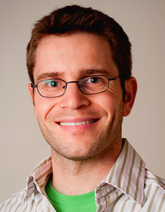ME Seminar on "Nonlocal continuum modeling of granular flows"
Events | Mechanical Engineering
ME Seminar on "Nonlocal continuum modeling of granular flows"
March 2, 2015 3:00 AM

Speaker
Dr. Ken Kamrin, Department of Mechanical Engineering, Massachusetts Institute of Technology
Location
**Engineering II, Rm. 2243**
Type
Seminar
Abstract:
Granular matter is very common --- sands, soils, raw materials, food stuffs, pills and powders --- but the challenge of predicting the motion of a collection of flowing grains has proven to be a difficult one, from both computational and theoretical perspectives. Grain-by-grain discrete element methods can be used, but these approaches become computationally unrealistic for large bodies of material and long times. A broadly accurate continuum model would be ideal if it could be found, as it would provide a much more rapid means of calculating flows in real-world problems, such as those encountered in industrial design and geotechnical engineering.
With this challenge in mind, in this talk we present a new constitutive relation for granular matter, which produces quantitatively accurate predictions. The model is constructed in a step-by-step fashion. First we compose a local relation based on existing granular rheological approaches (i.e. the principle of "inertial" rheology) and point out where the model succeeds and where it does not. The clearest missing ingredient is shown to be the lack of an intrinsic length scale. To tie flow features more carefully to the characteristic grain size, we justify a nonlocal modification which takes the form of a size-dependent term in the rheology (with one new material parameter). The nonlocal model is then numerically implemented with a custom-written User-Element in the Abaqus package, where it is shown to greatly improve flow predictions compared to the local model. In fact, it is the first model to accurately predict all features of flows in `split-bottom cell' geometries, a decade-long open question in the field. In total, we will show that this new model, using three material parameters, quantitatively matches the flow and stress data from over 160 experiments in several different families of geometries. We then show how the same model can be used to reconcile many of the "strange" features of granular media that have been documented in the literature, such as the observation that thinner granular layers behave as if they are stronger, and the motion-induced "quicksand" effect wherein flow at one location effectively removes the yield stress everywhere.
Bio:
Professor Ken Kamrin received a BS in Engineering Physics and a minor in Mathematics at UC Berkeley in 2003, and received his PhD in Applied Mathematics at MIT in May 2008. He worked for three years as an NSF Postdoctoral Research Fellow and course lecturer at Harvard University in the School of Engineering and Applied Sciences. In 2011, Kamrin joined the faculty of the department of Mechanical Engineering at MIT, and shortly thereafter received an appointment as the Class of 1956 Career Development Chair. Kamrin's research focuses on constitutive modeling and computational continuum mechanics for large deformation processes, with interests spanning elastic and plastic solid modeling, flow processes, and amorphous solid mechanics. Kamrin has been awarded fellowships from the Hertz foundation, US Defense department, and NSF. Kamrin received the 2010 Nicholas Metropolis Award from the American Physical Society for his work in computational physics, and the 2014 Eshelby Mechanics Award for Young Faculty. He received the NSF CAREER Award in 2012.